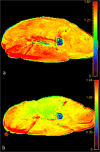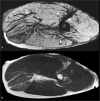Feasibility Study of MRI Muscles Molecular Imaging in Evaluation of Early Post-Mortem Interval
- PMID: 31942017
- PMCID: PMC6962370
- DOI: 10.1038/s41598-019-57357-z
Feasibility Study of MRI Muscles Molecular Imaging in Evaluation of Early Post-Mortem Interval
Abstract
Estimating early postmortem interval (EPI) is a difficult task in daily forensic activity due to limitations of accurate and reliable methods. The aim of the present work is to describe a novel approach in the estimation of EPI based on quantitative magnetic resonance molecular imaging (qMRMI) using a pig phantom since post-mortem degradation of pig meat is similar to that of human muscles. On a pig phantom maintained at 20° degree, using a 1.5 T MRI scanner we performed 10 scans (every 4 hours) monitoring apparent diffusion coefficient (ADC), fractional anisotropy (FA) magnetization transfer ration (MTR), tractography and susceptibility weighted changes in muscles until 36 hours after death. Cooling of the phantom during the experiment was recorded. Histology was also obtained. Pearson's Test was carried out for time correlation between post-mortem interval and MRI data. We found a significative inverse correlation between ADC, FA, MT values and PMI. Our preliminary data shows that post-mortem qMRMI is a potential powerful tool in accurately determining EPI and is worth of further investigation.
Conflict of interest statement
The authors declare no competing interests.
Figures









Similar articles
-
The use of whole body diffusion-weighted post-mortem magnetic resonance imaging in timing of perinatal deaths.Int J Legal Med. 2018 Nov;132(6):1735-1741. doi: 10.1007/s00414-018-1906-5. Epub 2018 Jul 28. Int J Legal Med. 2018. PMID: 30056622 Free PMC article.
-
Forensic Proteomics for the Discovery of New post mortem Interval Biomarkers: A Preliminary Study.Int J Mol Sci. 2023 Sep 27;24(19):14627. doi: 10.3390/ijms241914627. Int J Mol Sci. 2023. PMID: 37834074 Free PMC article.
-
A human post-mortem brain model for the standardization of multi-centre MRI studies.Neuroimage. 2015 Apr 15;110:11-21. doi: 10.1016/j.neuroimage.2015.01.028. Epub 2015 Jan 14. Neuroimage. 2015. PMID: 25595502
-
Post-mortem CT and MRI: appropriate post-mortem imaging appearances and changes related to cardiopulmonary resuscitation.Br J Radiol. 2016;89(1058):20150851. doi: 10.1259/bjr.20150851. Epub 2015 Nov 12. Br J Radiol. 2016. PMID: 26562099 Free PMC article. Review.
-
The role of diffusion tensor imaging and fractional anisotropy in the evaluation of patients with idiopathic normal pressure hydrocephalus: a literature review.Neurosurg Focus. 2016 Sep;41(3):E12. doi: 10.3171/2016.6.FOCUS16192. Neurosurg Focus. 2016. PMID: 27581308 Review.
Cited by
-
Diffusion Tensor Imaging of Rat Rotator Cuff Muscle With Histopathological Correlation: An Exploratory Study.NMR Biomed. 2025 Jun;38(6):e70058. doi: 10.1002/nbm.70058. NMR Biomed. 2025. PMID: 40326552
-
23Na MRI quantification of sodium content in porcine eyes after immersion in saltwater and freshwater en route to time in water estimation.Eur Radiol Exp. 2025 Jul 9;9(1):66. doi: 10.1186/s41747-025-00605-x. Eur Radiol Exp. 2025. PMID: 40634776 Free PMC article.
-
Current Understanding and Future Research Direction for Estimating the Postmortem Interval: A Systematic Review.Diagnostics (Basel). 2025 Aug 4;15(15):1954. doi: 10.3390/diagnostics15151954. Diagnostics (Basel). 2025. PMID: 40804918 Free PMC article. Review.
-
Magnetism of materials: theory and practice in magnetic resonance imaging.Insights Imaging. 2021 Dec 4;12(1):179. doi: 10.1186/s13244-021-01125-z. Insights Imaging. 2021. PMID: 34862955 Free PMC article. Review.
-
Effect of Post-mortem Interval and Perfusion on the Biophysical Properties of ex vivo Liver Tissue Investigated Longitudinally by MRE and DWI.Front Physiol. 2021 Aug 3;12:696304. doi: 10.3389/fphys.2021.696304. eCollection 2021. Front Physiol. 2021. PMID: 34413787 Free PMC article.
References
-
- Mathur A, Agrawal YK. An overview of methods used for estimation of time since death. Australian Journal of Forensic Sciences. 2011;43:275–285. doi: 10.1080/00450618.2011.568970. - DOI
MeSH terms
LinkOut - more resources
Full Text Sources
Medical

